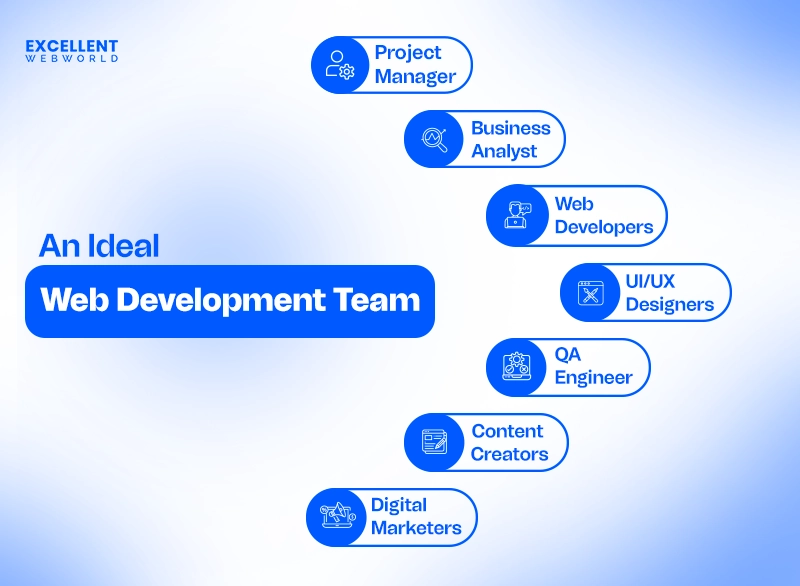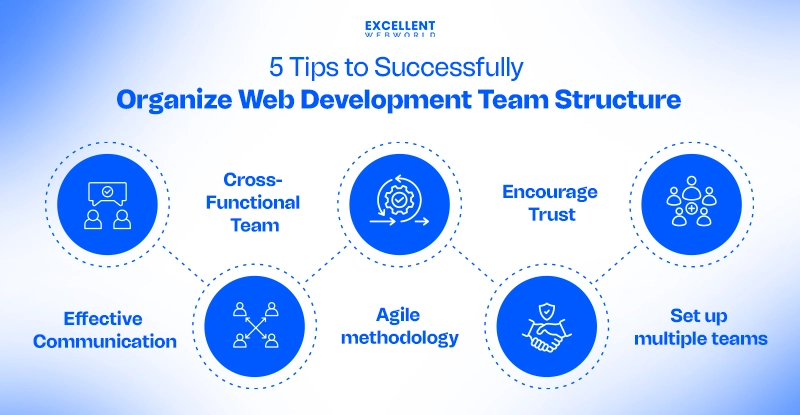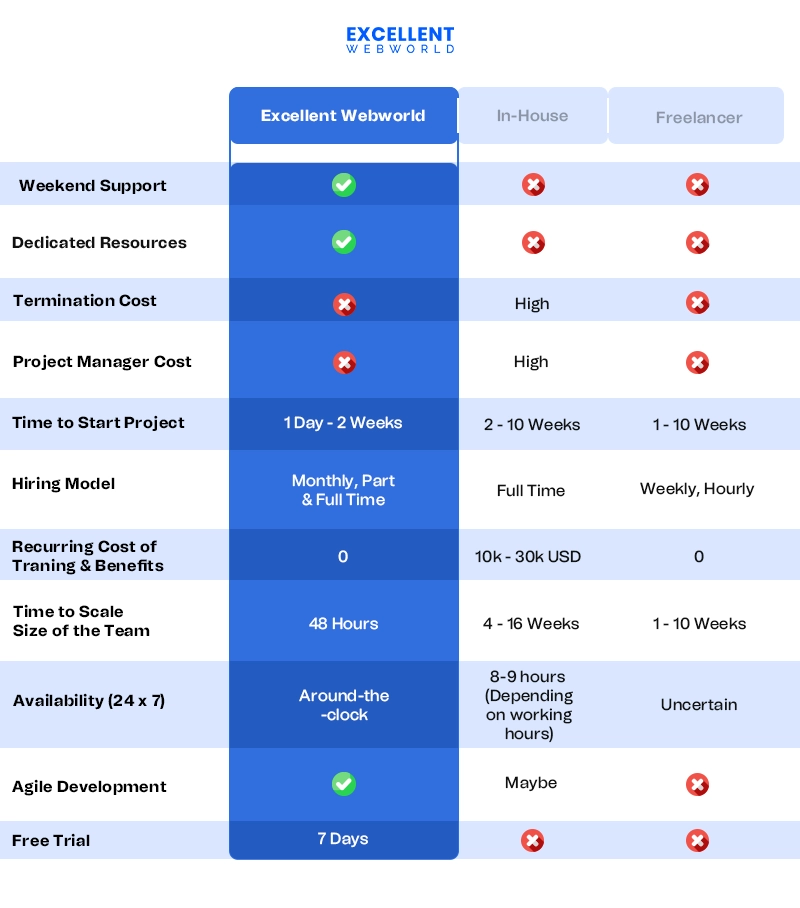According to a report, 67% of website development projects fail because of poor team management. But what leads to poor management? Is it a lack of managerial skills, an unstructured team, or something else?
The answer is simple – structure!
Without proper formation, winning a football or web development game is complex. Companies need a web development team structure that defines roles and simplifies team management. It helps with budget and time management and improves product quality.
In this article, you’ll learn things like how to build a web development team, how to manage a web development team, and more.
What is a Web Development Team?
A web development team comprises professionals responsible for a smooth development and deployment of web applications.
A structured team helps you estimate the project cost. A project plan includes the required team size and experienced members, giving you an idea of the cost.
The development team builds solutions from scratch, and for that, you need a team structure that looks like this:
However, the project manager oversees the execution of tasks, and others collaborate accordingly. After the website has been developed, the QA engineer ensures its quality and performance. You can also get help from experts who provide IT project management consulting services that help with planning, execution, and risk mitigation.
Key Roles In A Web Development Team Structure
Web development is not about writing codes and deploying them. The complete website development process involves multiple steps requiring coordination from other team members.
So, let’s get into each team member’s roles and responsibilities to understand their contribution.
1. Project Manager (PM)
The project manager oversees the end-to-end execution of web projects, ensuring adherence to quality, timelines, and budget and resolving bottlenecks. Thus, the PM can be considered the project lead. The PM should implement the best methodologies and motivate the team.
Additionally, coordinate with all stakeholders like architects, engineers, contractors, and vendors for seamless project execution.
Here are some skills you should know before hiring a Project Manager:
You can hire a full-time PM, allocate a budget, or outsource to a web development service. This role is crucial for monitoring all the activities of your web development team.
2. Business Analyst
This professional analyzes the goal of your IT project and transforms the ideas into digital products. A business analyst draws up timeframes with a price estimate, so you require a BA at any stage.
Before hiring someone for this role, ensure that they have characteristics like:
3. Web Developer
Before hiring web developers, you must know they are experienced in taking up the project requirements and creating functional web application architecture based on them. The website has two parts: one is front-end, and the second is back-end and developers accordingly:
Front-End Developer
The role of a front-end developer is to handle the client side of a website using cutting-edge technologies like HTML, AngularJS, and React. These developers should have experience with popular front-end technologies.
Back-End Developer
The role of a back-end developer is to write server-side code that powers the website’s features using technologies like JavaScript and Python.
However, you should consider one more developer type in the web development team structure. It’s a hybrid of front-end and back-end development called full-stack development.
Full-Stack Developer
These developers have web tech-stack skills, including client-side and server-side development. That means these developers can develop both the client and server sides of the project.
Here are some skills you should know before hiring a Full-stack web developer.
4. UI/UX Designer
Understanding the psychology of target users is crucial to building a product’s brand value. UI/UX designers address the problems users face while using web apps. It is not just about placing icons or creating web templates; designers are responsible for making the end users like the product.
These professionals are experienced and understand the product’s business potential. It helps them strategically place conversion funnels on pages that convert into orders.
So, before hiring UI/UX designers, you must ensure they can understand the user requirements and make a perfect series of interactions from every component. This enhances the user experience of the web application.
Additionally, UI/UX designers are skilled in HTML, CSS, and JS, which helps them make the interface technically robust.
Before hiring someone for this role, ensure that they have characteristics like:
5. QA and Testing Engineer
Testers are responsible for the web app’s performance and ensure there are no issues with functionality, such as bugs or defects. As part of this process, web application penetration testing is often performed to identify potential security vulnerabilities. Every team requires a QA who plays a vital role throughout the development cycle.
Essential attributes of a QA and testing engineer:
6. DevOps Engineer
DevOps engineers implement the automated process for seamless development, testing, and deployment. They implement CI/CD to ensure continuous improvements and ensure collaboration between the development and operations teams.
Before hiring someone as a DevOps engineer, ensure that they have these traits:
7. Solution Architect
The solution architect establishes the project framework, which acts as a blueprint for designers and developers. The primary task of the solution architect is to understand and create an in-depth wireframe that connects the different aspects of the website.
The solution architect should be able to:
However, you can review the company’s portfolio to learn more about the team’s experience and hiring. But how do you organize the team? Let’s explore the tips to manage your web development team.
Tips to Successfully Organize Web Development Team Structure
Planning, managing, and working to build websites can be achieved with an organized web development team structure. The tips below will help you successfully organize your web development team structure.
1. Effective Communication
Before you start organizing your web development team, it is crucial to set up a well-defined communication framework that will work during the project. Project managers ensure everyone is on the same page, and robust communication enhances this with collaboration and an understanding of responsibilities.
Here are communication’s key aspects to enhance collaboration:
Transparency
Open communication builds team members’ trust and creates a healthier collaborative environment.
Clear expectation
Define clear responsibilities and deadlines, minimize confusion, and improve project timelines.
Regular feedback
Frequent feedback helps improve individual performances and reduce the area of improvement.
Communication channels
You need to use communication tools for situations, such as scrum meetings and emails, as well as management tools like Jira and Trello.
2. Cross-Functional Team Structure
As mentioned earlier, cross-functional teams are crucial and have advantages. A cross-functional team structure creates an environment where people can freely participate in different areas and roles. This contributes to team growth, enhances communication efficiency, and improves project performance.
3. Agile Methodology
Sometimes, you cannot do away with the need to plan. It is strongly recommended to use agile methodology. The agile method helps the development team to improve project planning and timelines. The result is a shorter lifecycle, higher performance, and continuous improvements.
4. Encourage Trust
Team members need to trust each other. They need to work in a manner that will increase the level of trust. They must share their ideas and experiences to improve the overall quality of service and products.
5. Always Set Up Multiple Teams
Having different teams can be very beneficial. You can set up different teams depending on the requirements. For this to happen, you may have to create several teams with different versions, and you can conduct A/B testing to get the best website version.
What Does an Excellent Web Development Team Do?
An excellent web development team can fulfill the business’s goals. The development team requires both collaboration and individual contributions.
Building projects require teamwork and individual contributions. Each team member must contribute unique skills and help other team members when needed.
Here’s a list of things to remember to get the best from your web development team.
Mistakes You Must Avoid When Building A Web Development Team Structure
1. Spending Too Much Time to Plan
Spending too much time in the planning phase can pressure stakeholders unnecessarily. You have to divide the project into smaller, easier-to-manage tasks. This helps you to give flexibility and makes it simpler to get feedback to improve the project plan constantly.
2. Emphasize the Importance of One Role Compared to Others
A web development team comes with variety and specialization in their tasks. Some roles will be more critical than others. Instead of focusing on one role, spend more time delegating and allocating tasks for better speed.
3. Not Having a Clear Communication Plan
It is essential to have meaningful communication channels between key stakeholders. Having clearly defined communication channels helps detect dangerous situations before they occur.
4. Hiring Budget
While building a web development team, keep an eye on your hiring budget. The budget depends on the project requirement, whether you need a team with a low or high budget. The key variation is expertise and experience within each team.
As you know, mistakes are something that you must avoid while building a web development team, but you should also consider these approaches to create a healthy work environment and a successful team structure.
How to Find Success with Your Web Development Team Structure?
The web development team is a set of professional engineers responsible for building and managing the code of websites and web apps. Creating a good team structure requires essential attributes like leadership, strong communication, and trust among team members. This will create a healthy environment and improve the quality of the work.
Here are the tips to help you create a healthy web development work environment:
Why Build Your Web Development Team with Excellent Webworld?
The above article should have helped you understand how to build a web development team. However, one critical aspect of this process is understanding the nuances of the expertise of different roles. Excellent Webworld is an experienced web development company with industry expertise.
We have over 13 years of experience providing web development services. Our team of experts has successfully developed high-performance web apps that integrate advanced AI and AR/VR technologies. With more than 900 successful projects, our experts have catered to different client needs in web development.
We are a leading web development company that offers end-to-end development and integration for AI practices. Contact us now to learn more about our solutions.
FAQs
You must frequently collaborate with experts in different roles, such as UI/UX designers, QA, project managers, developers, and business analysts.
You need to define project requirements and business goals. After that, search for reputable software development companies and check their company portfolio and communication skills. Schedule a meeting or interview with the team to discuss project details and get a quote.
To organize a web development team, you must define its roles and responsibilities. This establishes the team’s structural workflow and sets priorities. Use project management tools for open communication and task prioritization.
The web development team is responsible for building, designing, and maintaining web solutions. It handles all aspects of web application development, including planning, code, user interface, and testing.
When you look for a web development team, include priorities like technical skills in development languages & frameworks. Additionally, communication skills and problem-solving abilities matter a lot.

Article By
Paresh Sagar is the CEO of Excellent Webworld. He firmly believes in using technology to solve challenges. His dedication and attention to detail make him an expert in helping startups in different industries digitalize their businesses globally.






